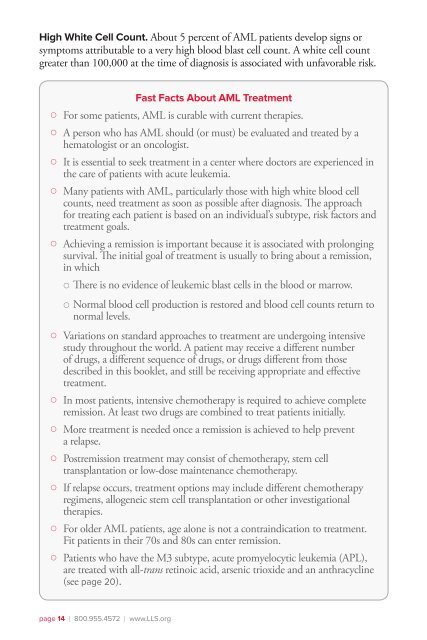Acute Myeloid Leukemia - The Leukemia & Lymphoma Society
Acute Myeloid Leukemia - The Leukemia & Lymphoma Society
Acute Myeloid Leukemia - The Leukemia & Lymphoma Society
- No tags were found...
You also want an ePaper? Increase the reach of your titles
YUMPU automatically turns print PDFs into web optimized ePapers that Google loves.
High White Cell Count. About 5 percent of AML patients develop signs orsymptoms attributable to a very high blood blast cell count. A white cell countgreater than 100,000 at the time of diagnosis is associated with unfavorable risk.Fast Facts About AML Treatment◦{For some patients, AML is curable with current therapies.◦{A person who has AML should (or must) be evaluated and treated by ahematologist or an oncologist.◦{It is essential to seek treatment in a center where doctors are experienced inthe care of patients with acute leukemia.◦{Many patients with AML, particularly those with high white blood cellcounts, need treatment as soon as possible after diagnosis. <strong>The</strong> approachfor treating each patient is based on an individual’s subtype, risk factors andtreatment goals.◦{Achieving a remission is important because it is associated with prolongingsurvival. <strong>The</strong> initial goal of treatment is usually to bring about a remission,in which◦ { <strong>The</strong>re is no evidence of leukemic blast cells in the blood or marrow.◦{Normal blood cell production is restored and blood cell counts return tonormal levels.◦{Variations on standard approaches to treatment are undergoing intensivestudy throughout the world. A patient may receive a different numberof drugs, a different sequence of drugs, or drugs different from thosedescribed in this booklet, and still be receiving appropriate and effectivetreatment.◦{In most patients, intensive chemotherapy is required to achieve completeremission. At least two drugs are combined to treat patients initially.◦{More treatment is needed once a remission is achieved to help preventa relapse.◦{Postremission treatment may consist of chemotherapy, stem celltransplantation or low-dose maintenance chemotherapy.◦{If relapse occurs, treatment options may include different chemotherapyregimens, allogeneic stem cell transplantation or other investigationaltherapies.◦{For older AML patients, age alone is not a contraindication to treatment.Fit patients in their 70s and 80s can enter remission.◦{Patients who have the M3 subtype, acute promyelocytic leukemia (APL),are treated with all-trans retinoic acid, arsenic trioxide and an anthracycline(see page 20).page 14 I 800.955.4572 I www.LLS.org
















